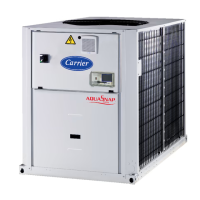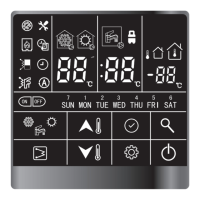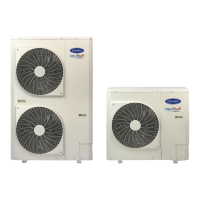41
Never be tempted to start the heat pump without reading
fully, and understanding, the operating instructions and
without having carried out the following pre-start checks:
•
Check the chilled water circulation pumps, air handling
units and all other equipment connected to the evaporator.
• Refer to the manufacturer’s instructions.
• For units without hydronic module, the water pump
overheat protection device must be connected in series
with the pump contactor power supply.
• Refer to the wiring diagram supplied with the unit.
• Ensure that there are no refrigerant leaks.
• Conrm that all pipe securing bands are tight.
• Conrm that the electrical connections are secure.
IMPORTANT:
• Commissioning and start-up of the heat pump must be
supervised by a qualied refrigeration engineer.
• Start-up and operating tests must be carried out with
a thermal load applied and water circulating in the water
heat exchanger.
• All set point adjustments and control tests must be
carried out before the unit is started up.
• Please refer to the 30RB/30RQ Touch Pilot Junior
control manual.
The unit should be started up in Local ON mode.
Ensure that all safety devices are operational, especially that
the high pressure switches are switched on and that the alarms
are acknowledged.
The control of a master/slave assembly is in the entering
water and does not require any additional sensors (standard
conguration). It can also be located in the leaving water. In
this case two additional sensors must be added on the
common piping.
All parameters, required for the master/slave function must
be congured using the Service Conguration menu. All
remote controls of the master/slave assembly (start/stop, set
point, load shedding, etc.) are controlled by the unit congured
as master and must only be applied to the master unit.
Depending on the installation and control type, each unit can
control its own water pump. If there is only one common
pump for the two units, the master unit can control this. In
this case shut-off valves must be installed on each unit. They
will be activated at the opening and closing by the control of
each unit (and the valves will be controlled using the
dedicated water pump outputs).
1 Master unit
2 Slave unit
Water inlet
Water outlet
Water pumps for each unit (included as standard for units with hydronic
module)
Connection of two additional sensors
Check valve
T

